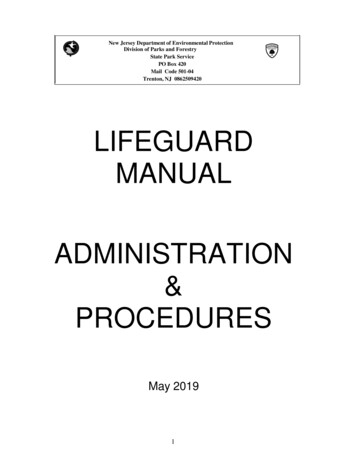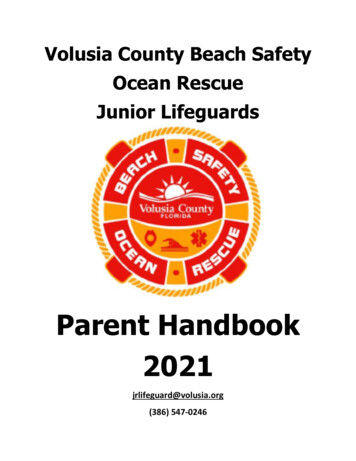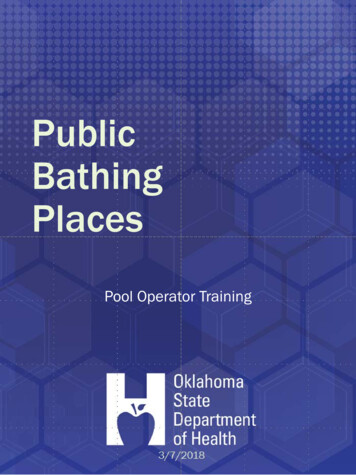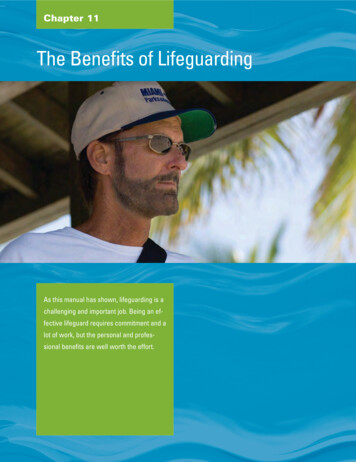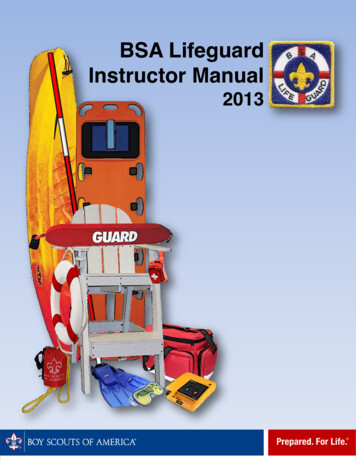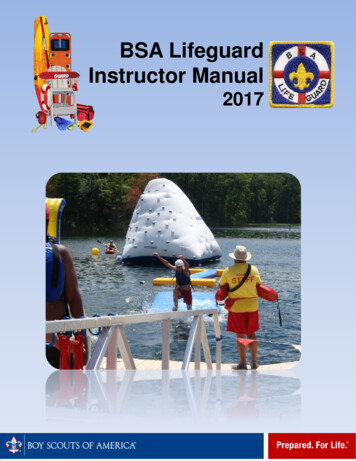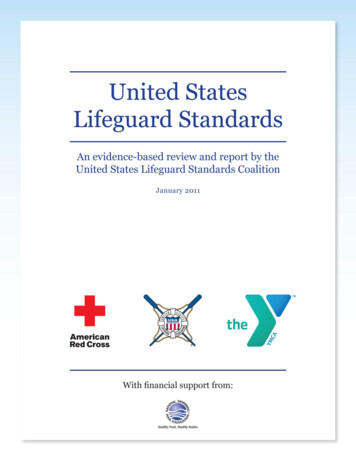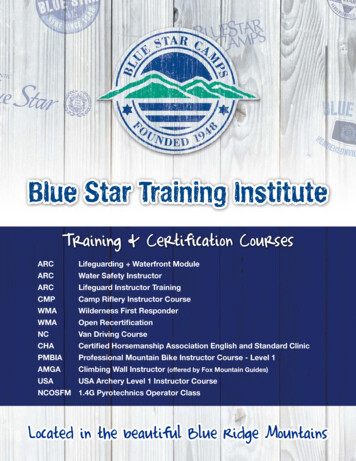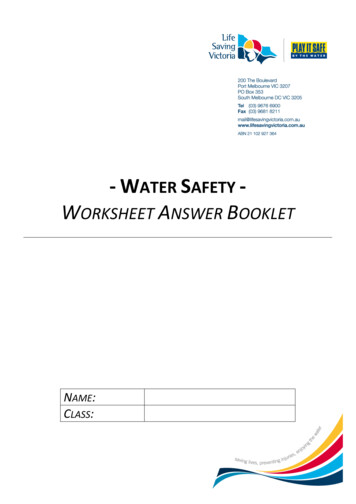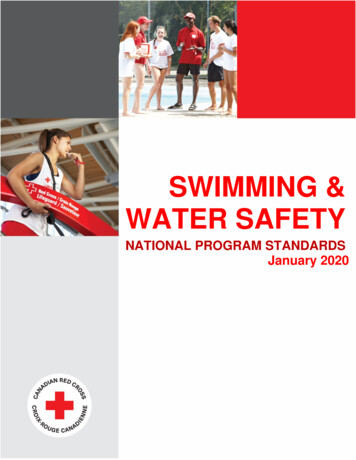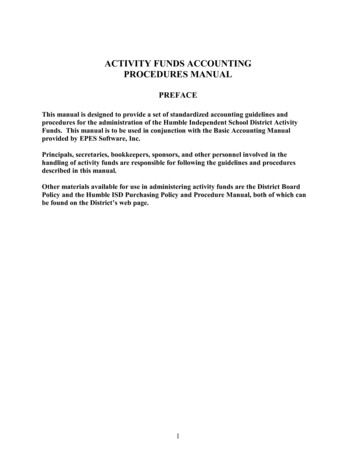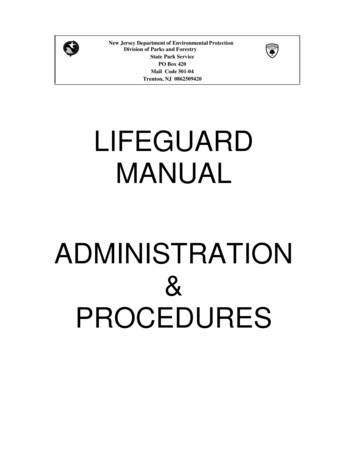
Transcription
New Jersey Department of Environmental ProtectionDivision of Parks and ForestryState Park ServicePO Box 420Mail Code 501-04Trenton, NJ 0862509420LIFEGUARDMANUALADMINISTRATION&PROCEDURES
TABLE OF CONTENTSChapter123456789101112PageLifeguard RecruitmentEmployment Test and Hiring ProceduresLifeguard in Training ProgramLifeguard TrainingLifeguard StaffingRecords and DocumentsEquipment, Supplies and UniformsSeasonal Opening and Closing/Temporary ClosingCommunicationsFlotation Devices for Disabled PersonsWater Sampling at Bathing BeachesHepatitis Vaccination And Pathogen Exposure uitment FlyerPermission Slip for Applicants Under 18Lifeguard Physical FormHepatitis B Immunization FormTraining AssignmentsFreshwater Daily ReportOcean Daily ReportYear End Lifeguard Activity ReportLake Lifeguard Training RecordOcean Lifeguard Training RecordLifeguard Physical Training RecordFirst Aid ReportLifeguard EvaluationEmployment Test Score SheetBi-Weekly Time SheetDeath or Serious Injury ReportFirst Aid Equipment InventoryFirst Aid Supplies InventoryLifeguard EquipmentPWC Maintenance LogBathing Area DiagramUSLA RosterCopies of First Aid, CPR, & USLA CardsLifeguard Stand BlueprintsUniform RequestBeach Wheelchair Sign-OutBloodbourne Pathogen Exposure Control Plan CPR/FA 5A-26A-27-A-29A-30A-31A-32
Chapter 1 – LIFEGUARD1 RECRUITMENTI. Recruiting Returning LifeguardsA. All lifeguards should leave a winter address prior to termination. This will enable eacharea to contact that lifeguard in January. The previous summer’s lifeguards should becontacted with a letter that includes the following:1. An offer of employment as a lifeguard for the upcoming season.2. Pay Scale.3. Upcoming season information and test dates if available.B. Each returning lifeguard should be contacted again at the beginning of March with aletter that includes test dates and an application.C. Before sending letters offering a returning guard summer employment, be sure to reviewhis/her previous year’s evaluation.II. Recruiting New LifeguardsA. Recruitment posters and brochures should be sent to swim coaches, athletic directorsand guidance counselors in December. Sample flyer page A-1.B. Lifeguard job information must be available to all employees answering phones in thearea office. This information will include the date, time, location, components of theemployment test and starting salary. In addition, it should be made clear to allapplicants under 18 years of age that a permission slip must be signed by a parent orlegal guardian prior to taking the lifeguard employment test. They should also beinformed that wetsuits are not permitted. This will make it easy for office personnel togive lifeguard information over the telephone. This information should be in theoffice starting January 1.C. Office personnel should record names, addresses and telephone numbers of all theinterested parties. An application, permission slip and other pertinent informationshould be sent to all interested candidates. These candidates should be contacted againabout two weeks prior to the lifeguard test to be reminded of the test.3
Chapter 2 – EMPLOYMENT TEST AND HIRING PROCEDURESAll lifeguards and lifeguard officers must pass the NJ State Park Service Lifeguard EmploymentTest prior to performing lifeguard functions each season.I. Components of Test and Passing ScoresA. 500 Meter Swim1. Open Water Test (Given when pool is not available)Applicant starts on beach and runs into waist-deep water then swims to and touches amarker 250 meters from the water line and returns to the starting point. Passing timeis 10 minutes or less.2. Pool TestApplicant starts in the pool (diving is not permitted) and swims 20 lengths in a 25meter pool or 3 yards short of 22 lengths in a 25 yard pool. Flip turns are allowed.Passing time is 10 minutes or less.B. 400 Meter RunCandidate will run 400 meters with sneakers on a track or other hard surface. Passingtime is 1 minute 40 seconds or less.II. Testing CriteriaA. Test will be organized and administered by Water Safety Supervisor (WSS) or a RegionalSuperintendent designee.B. The two parts of the test must be taken and passed simultaneously.C. If one part of the test is failed the whole test must be retaken.D. Rest time and changing time between events is a maximum of 10 minutes.E. Events will be timed by WSS or Superintendents.F. No wetsuits can be worn during the test.G. Returning guards will staff boats with rescue buoys and kayaks with rescue buoys forsafety during tests in open water.H. Heats for open water testing should contain a number of applicants that can besafely covered by boats and kayaks.4
I. All candidates under 18 years of age must have an official State Park Service permission slipsigned by a parent or legal guardian in order to take the employment test. Candidates over18 must have acceptable proof of age. Sample form page A-2.J. Employment test record forms ( A- 16) will be completed by WSS andforwarded to the appropriate Superintendent.K. No exceptions.III. Hiring ProceduresThese procedures are for both new and returning lifeguards.A. Applicants must be interviewed by the Superintendent.B. Applicants hired must be given a lifeguard physical form with accompanying directionsabout how it should be completed. This physical form may not be photocopied andmust have the physician’s seal or stamp affixed. If these conditions are not met, theform will be considered invalid. All Lifeguards must have lifeguard physical formcompleted by an M.D., D.O., nurse practitioner, or physicians assistant prior toperforming lifeguard functions for the public. Training and maintenance functions arepermitted before physical form is completed. This form should be kept in the personnelfile at the area office. Sample form on page A-3.C. Lifeguard must be notified of training requirements, scheduled classes, and the manualtest.D. Lifeguards must get working papers from their high school if they are under 18 years ofage.E. Hepatitis B Immunization Form (page A-4) must be sent to the Trenton Lifeguardcoordinator. All lifeguards regardless of whether they filled out this form in the pastmust complete the form. If the Lifeguard is a minor, a parent or legal guardian must sign.F. Employment package must be sent to the Office of Visitor Services and ProgramSupport.5
Chapter 3 – LIFEGUARD IN TRAINING PROGRAMThis program is for parks that can not get enough lifeguards to complete their staff becausethe applicants can not pass the lifeguard employment test. This program is not for returningguards who are out of shape and can not pass the test.1. The objective of the program is to hire candidates who fail the lifeguardemployment test but show potential to pass. When hired, these candidates will becalled “Lifeguard in Training”.2. Returning lifeguards will train people hired for the lifeguard in training program.3. The “Lifeguard in Training” will follow a structured program of stretching,running, swimming and stroke instruction.4. The program will be used when it appears the lifeguard staff will not be filled. Ifit is early in the spring, pool time must be acquired.5. This program will not work if an area does not recruit applicants.6. The “Lifeguard in Training” will be hired at 8.38 per hour.7. The “Lifeguard in Training” must meet and/or carry out the following criteria:A. Failed lifeguard employment test but shows potential to pass. Swimtime is no more then 12 minutes and run time is no more then 2 minutes.B. Willing to work up to 15 hours a week on swimming, running and endurance.C. Show progress each week to a maximum of 3 weeks. If employee does notpass the test after 3 weeks he/she will be terminated.D. Successful completion of employment test will result in employment as alifeguard and employee will enter State Park Service Lifeguard TrainingProgram.E. Will not be issued or wear a lifeguard uniform.F. Will not perform any lifeguard duties or sit on a lifeguard stand.G. Will adhere to a work schedule agreed to by head lifeguard andSuperintendent. Preferably during slow times of the day.6
8.When training “Lifeguard in Training”, make sure the public is adequatelyprotected. A guard must be in the stand when training takes place in thewater and kayaks should be used on buoy swims. Do not compromisetrainee’s or public’s safety.9.If the guards working with the “Lifeguard in Training” do not have a positiveattitude and encourage these people, the program will fail!7
Chapter 4 – LIFEGUARD TRAININGThis chapter will outline the training that must be completed by returning guards and newguards prior to and during the recreational bathing season. The training program isrequired by the New Jersey Department of Health and Senior Services and approved bythe United States Lifesaving Association (USLA).Training of lifeguard procedures, water skills, physical training, and other relatedmaterial will be carried out by lifeguard officers in consultation with the Regional WaterSafety Supervisor (WSS).I. Training Returning Guards-Lifeguard SkillsA. Essential skills and procedures which must be reviewed by all returning lifeguards and officersprior to working as a lifeguard.This training will be referred to as primary training. The material to be covered inprimary training is listed below and must be done to the satisfaction of a lifeguardofficer. Training sessions will be planned prior to opening day by lifeguard officersand the WSS.Primary training:1. Rescue Procedures and All Related Procedures (Hand Signals, Telephone, Etc.)2. Torpedo Buoy Rescuesa. Conscious Victimb. Unconscious Victim (on surface and submerged), discuss in water rescuebreathingc. Multiple Victims3. Kayak/Rescue Board Rescues (Rescue Boards at Island Beach State Park Only)a. Conscious Victimb. Unconscious Victim, discuss in water rescue breathingc. Multiple Victims4. Non-equipment Rescue techniques as listed on lifeguardtraining record.5. Removal of victim from shallow water to beach6. Mask, Fins and Snorkel7. Sighted submersion8. Water Search for a lost person not sighted by a lifeguard8
9. Spinal Injuriesa. Backboard and related equipmentb. Skills needed to care for spinal injury in deep and shallow water10. Scanninga. Discuss what to look forb. Previous experiencesc. Correcting problems observed11. Personal Water Craft (Designated personnel at Island Beach State Park)a. Handling and safetyb. Off beach usec. Rescues12. All Terrain Vehicle (Designated personnel at Island Beach State Park)a. Handling and safetyb. Off beach usec. Recommended uses13. Off Beach Rescue Team Procedures (Designated personnel at Island Beach)14. Review of Area (Facilities, Signs, Park Communications, Etc.)B. A returning lifeguard is required to pass a written test on the lifeguard manual beforeworking as a lifeguard.1. The manual test will be given by the WSS or his/her designee. Care must be taken toinsure the validity of these tests.2. Any cheating on the manual test will result in the dismissal of all persons involved.3. The passing grade on the Lifeguard Manual Test is 90. Incorrect answers must becorrected.C. Generally speaking, most returning guards will have current American Red Cross CPRand First Aid certifications.1. American Red Cross: First Aid and CPR textbooks must be read and reviewed byreturning guards prior to working as a lifeguard.a. The Superintendent should ensure that a returning guard reviews this materialif recertification does not take place prior to the season.9
D. Remainder of skills to be reviewed by returning guards (secondary training).The secondary material is not part of the standard operating procedure and does not haveto be reviewed prior to working as a lifeguard. The material should be reviewed duringthe first three (3) weeks of employment. The material should be reviewed before 10 a.m.or during the day provided the bathing area is properly supervised. This secondarymaterial will be done to the satisfaction of a lifeguard officer. Secondary material to bereviewed is listed below:1. Boat handling and rescues. (Island Beach State Park Only)E. Renewal of Red Cross, CPR/AED and First Aid by returning guards.1. Superintendents should find out expiration dates on First Aid and CPR cards ofreturning guards prior to their working as a lifeguard.2. First Aid and CPR recertification courses will be scheduled as close to a guard’sexpiration date and as early in the season as possible. Red Cross CPR/AED,First Aid and Oxygen Administration are valid for 2 years. Red CrossBloodbourne Pathogen training is valid for 1 year.3. Arrangements for recertification courses will be made by the Superintendent withWSS and Regional First Aid/CPR Trainer.4. A lifeguard officer should see that the Red Cross textbooks are read by lifeguardsprior to taking the course.5. Bloodbourne pathogen training and oxygen administration instruction will beincluded in the CPR class.II. Training New Lifeguards – Lifeguard SkillsWhen training new lifeguards, one must remember this may be their first job and they areunfamiliar with the State Park Service and the job of lifeguarding. Everything must be taughtthoroughly.A. The following skills, materials and procedures are to be accomplished with a newlifeguard as soon as possible (primary training).These skills may be learned while the beach is open under the direct supervision ofreturning guards. A new lifeguard cannot work without direct supervision of experiencedguards until primary training is completed to the satisfaction of a lifeguard officer and thelifeguard has passed the manual test. Training periods should be prior to 10 a.m. orduring the day provided the bathing area is properly supervised. A good method fortraining new guards is to have them learn lifeguard skills and practice these skills at theirarea for a few weeks and then have a day of training and skill testing with a maximum of10
10 new guards under the direction of the WSS and a lifeguard officer. Primary trainingmaterial is listed below.1. General introduction to assigned area, chain of command, lifeguard trainingprogram and Lifeguard Manual.2. Readinga. Lifeguard Manual and Seasonal Employee Manualb. The passing grade on the Lifeguard Manual Test is 90. Incorrect answers must becorrected.3. Communicationsa. Hand signalsb. Whistle signalsc. Summoning aid: i.e., State Park Police, area office, other lifeguards,ambulances, etc. in accordance with emergency proceduresd. Telephone and radio procedures4. Rules and Regulationsa. Beach and bathing areab. Personnelc. Uniform5. Torpedo buoy rescuesa.b.c.d.Conscious VictimUnconscious Victim (on surface and submerged) discuss rescue breathingMultiple VictimsLeaving stand and entry into water6. Kayak/Rescue Board Handling (Rescue Board at Island Beach State Park Only)a.b.c.d.PaddlingTurningStoppingCareful Usage7. Kayak/Rescue Board Rescues (Rescue Board at Island Beach State Park Only)a. Conscious Victimb. Unconscious Victim, discuss rescue breathingc. Multiple Victim11
8. Rescue proceduresSet up situations relative to your bathing area with one stand, two stands, deep waterpatrol, etc., and have guards carry out their responsibility at different positions forsimulated rescues.9. Masks, Fins and Snorkel10. Sighted submersion by a lifeguard11. Water Search for a lost person not sighted by a lifeguard12. Backboard skillsa. Used as a stretcherb. Used with related equipment in caring for a spinal injury in the water and on thebeach13. Personal Water Craft (Designated personnel at Island Beach State Park)a. Handling and safetyb. Off beach usec. Rescues14. All Terrain Vehicle (Designated personnel at Island Beach State Park)a. Handling and safetyb. Off beach usec. Recommended uses15. Scanninga. Discuss how to scan and what to look forb. Practice scanning on the stand and on deep water patrol under direct supervision ofan experienced guardc. Enforcing rules and regulations while scanning16. Public Relationsa. Discuss being politeb. Serving the publicc. Getting compliments, not complaints17. Non-equipment Rescue Techniques listed on training record (A-9)A. Remainder of material to be learned by new guards after they have completed primarytraining satisfactorily. The remaining material to be accomplished with the new guardswill be referred to as secondary training. Secondary training must be completed to thesatisfaction of a lifeguard officer or WSS.12
Secondary training for new guards is listed below:1. Boat handling (Island Beach State Park Only)2. Boat rescues (Island Beach State Park Only)B. First Aid and CPR/AED training for new guards.1. New guards will take CPR, First Aid, Bloodbourne Pathogen training and OxygenAdministration courses as soon as possible.2. Classes for CPR, First Aid, Bloodbourne Pathogen training and OxygenAdministration will be scheduled by the Superintendent with the WSS and RegionalFirst Aid/CPR Trainer.3. A lifeguard officer will see that new guards read the Red Cross textbooks prior totheir class.4. A new lifeguard will not perform CPR or First Aid until properly certified.III. In-service Training of All Lifeguards After Primary and Secondary Training Is SatisfactorilyCompleted Shall Be As Follows:A. Additional training in skills that a lifeguard officer and/or WSS feel are required forindividuals or entire lifeguard staff.B. According to training assignments issued each week by the WSS. Training assignmentswill start being issued approximately three (3) weeks into the season. Sample page A-5.1. Training assignments will be completed between 9:30 a.m. and 9:55 a.m. each day orduring low usage periods when the bathing area is properly supervised.2. Superintendents should periodically verify that training assignments are beingaccomplished by the lifeguards.IV. Physical Training of All LifeguardsA. It is the responsibility of the lifeguard officer to see that physical training is carried out byeach lifeguard according to the physical training requirements outlined in the lifeguardmanual.B. Physical training should be completed before 10:00 a.m. or on a lifeguard’s first breakfrom scanning provided the bathing area is properly supervised.13
C. Physical training as a group can be done prior to 10:00 a.m. provided no skill training isnecessary.D. Additional physical training may be accomplished during low usage or on other breaksprovided the bathing area is properly supervised.1. If a lifeguard works less then 5 days per week, a minimum of 2 physicaltraining requirements per day worked must be completed.14
Chapter 5 – LIFEGUARD STAFFINGI. Determining the Number of Lifeguards at Each Public Recreational Bathing AreaAdministered by the State Park ServiceThe WSS, area Superintendent and the Regional Superintendent will determine the numberof lifeguards needed to staff an area based on the criteria described below.A. The length of the beachfront that is protected by lifeguards. SPS policy calls for onelifeguard stand for approximately every 200 feet or less of freshwater beachfront and 300feet or less of ocean beachfront that is guarded. (The length of the beach guarded is thedesignated swim area in that park).B. Bathing Area1. Depth and slope2. The distance from the shore to the outside boundaryC. Usage of the area based on number of buses and past attendance figures to forecast days of:1. Maximum usage and the number of lifeguard stands and guarding positions needed.2. Moderate usage and the number of lifeguard stands and guarding positions needed.3. Low usage and the number of lifeguard stands and guarding positions needed.D. Allowance for days off based on a 40 hour work week for each guard.E. Time necessary for training requirements.F. The lifeguard officer(s) should be considered a lifeguard when determining the number oflifeguards needed to staff an area.G. Time necessary for breaks and lunches.II. Lifeguard Work Assignments and Position RotationsThe work assignments and rotations discussed in this section are a guide forutilizing the lifeguard staff efficiently. The work assignments and rotations beloware based on the number of lifeguards needed to supervise the public. Whenusage is low and the bathing area is properly supervised, lifeguards not neededmay use time to train or clean and maintain first aid rooms, locker rooms andother lifeguard related equipment. It is important to remember supervising bathersis a lifeguard’s first priority and other assignments are accomplished only duringlow usage.15
A. Work assignments and rotation1. Two (2) lifeguard rotation needed to supervise bathersa. One stand open with one or two lifeguards. When one guard is in the stand, theother guard must be in the vicinity of the beach and bathing area in the event helpis needed.b. Two lifeguards are used only during very low usage periods.2. Three (3) lifeguard rotation needed to supervise bathersa. One stand open with two lifeguardsb. One lifeguard will be covering first aid room, training, on break or deepwaterpatrolc. Thirty minute rotation3. Four (4) lifeguard rotation needed to supervise bathersa.b.c.d.One stand open with two lifeguards and one lifeguard on deepwater patrol ORTwo lifeguards on stand one, one lifeguard on stand two and no deepwater patrolOne guard covering first aid room, training or on breakThirty minute rotation4. Five (5) lifeguard rotation needed to supervise bathersa. Two stands open, two lifeguards on stand one, one lifeguard on stand two, onelifeguard on deep water patrol ORb. Two lifeguards on stand one, two lifeguards on stand twoc. One lifeguard covering first aid room, training or on breakd. Twenty minute rotation5. Six (6) lifeguard rotation needed to supervise bathersa.b.c.d.Two stands open, two lifeguards on stand one, two lifeguards on stand twoOne lifeguard on deepwater patrolOne lifeguard covering first aid room, training or on breakTwenty minute rotation16
6. Seven (7) lifeguard rotation needed to supervise bathersa. Two stands open, two lifeguards on stand one, two lifeguards on stand twob. One lifeguard on deepwater patrolc. One lifeguard covering first aid roomd. One lifeguard on break or traininge. Thirty minute rotation7. Eight (8) lifeguard rotation needed to supervise bathersa. Two stands open, two lifeguards on stand one, two lifeguards on stand twob. Two lifeguards on deepwater patrolc. One lifeguard covering first aidd. One lifeguard on break or traininge. Thirty minute rotation8. Nine (9) lifeguard rotation needed to supervise bathersa. Three stands open, two lifeguards on stand one, two lifeguards on stand two, onelifeguard on stand threeb. Two lifeguards on deepwater patrolc. One lifeguard covering First Aid Roomd. One lifeguard on break or traininge. Twenty minute rotation9. Ten (10) lifeguard rotation to supervise bathersa. Three stands open, two lifeguards on stand one, two lifeguards on stand two, onelifeguard on stand threeb. Three lifeguards on deepwater patrol or two lifeguards on deepwater with twolifeguards on stand threec. One lifeguard covering First Aid Roomd. One lifeguard on break or traininge. Twenty minute rotationB. Other information pertinent to work assignment rotation.1. Shallow water patrol should be used when needed as determined by a lifeguardofficer. The guard on shallow water patrol should first come from a two-personstand. When this is not possible, the guard may come from deep water patrol.Shallow water patrol is useful when there are problems or potential problems inshallow water or along the shoreline.2. Lifeguard officers are included in work assignment rotation.3. Level of training and skill of the lifeguard is taken into account when making workassignment rotation for the day.4. The work assignment rotation is assigned by a lifeguard officer.5 . Thirty-minute rotations are preferred to twenty-minute rotations.17
6. Lunch break is 30 minutes and should not be extended by other breaks immediatelybefore or after. No break will exceed 30 minutes.7. All State Park Service bathing areas are not the same. If a work assignment rotationother than the ones listed above is appropriate, it must be discussed with the WSS andthe Superintendent. The Superintendent is the final authority.8. Work assignment rotations are only listed for up to 10 lifeguards and 3 lifeguardstands. For more stands and lifeguards, work rotations should use the same logic andpatterns as described in section.C.Island Beach will have a separate work assignment rotation.III. Scheduling LifeguardsScheduling of lifeguards will be done by a lifeguard officer monthly, and then confirmedby the officer approximately three days prior to the start of each workweek. Theschedule should be approved by the Superintendent and reviewed by the WSS.Any changes needed in the schedule should be submitted in writing to the Superintendentas soon as possible by a lifeguard officer. If there is a scheduling problem that cannot besolved internally, it should be discussed with the WSS for possible assistance from otherareas in the region. When scheduling lifeguards, the following criteria must be taken intoconsideration:A. History of past attendance and buses scheduled. Using this information, theSuperintendent, lifeguard officer and WSS will forecast the days of low, moderateand heavy usage then schedule the appropriate number of guards. Example: Staffingis least on Mondays and most on Sundays.B. Number of guards available to work.C. Level of training of each guard.D. Days guards will be training and not available to supervise the bathing area.E. All lifeguard personnel are limited to 40 hours per week unless overtime is approvedby the area Superintendent.F. A lifeguard officer or designee must be present when the area is open to publicrecreational bathing.G. At least two guards must be currently certified in professional CPR.H. At least one guard must be certified in First Aid.18
I. Work assignment rotations are outlined in part II of this chapter. It is preferable toschedule a number of guards to permit 30-minute rotations. This is not alwayspossible due to availability of guards, absenteeism, etc.IV. Lifeguard Work DayA. Lifeguards will begin work at 9:30 a.m. at a designated location.B. A lifeguard’s day ends at 6:00 p.m. unless directed otherwise.C. A lifeguard officer’s day sometimes begins at 9:00 a.m. as determined by theSuperintendent to:1. Meet with Superintendent2. Accomplish record keeping and other administrative duties.19
Chapter 6 – RECORDS AND DOCUMENTSThe records and documents discussed in this chapter are important for the support andcredibility of the entire State Park Service Lifeguard Program. These are legal documents.Therefore, it is necessary that the Superintendent, with the assistance of the WSS, check thatthese records are kept up-to- date and accurate by the lifeguard officer. All entries intolifeguard records must be made with a non-erasable pen.According to NJAC 8:26 – 8.9 record keeping: accurate and complete records shall bemaintained and kept on the premises and shall be available upon request of the authorizedagent or health authority. Such records shall be kept for a minimum of one year, exceptthose records related to deaths, all injuries to the head, neck and spinal cord and any injuryrendering a person unconscious shall be kept for 10 years, and shall include:1.2.3.4.Water analysis results;Sanitary survey records;Daily number of bathers;Copies of all necessary credentials of personnel associated with the publicrecreational bathing operation(s);5. Accidents requiring external emergency services, including the patient’s name,time, date, description of occurrence, treatment, action taken and name of personon duty supervising the facility;6. Deaths and/or drownings. The record shall include the name of the person, thedate and a description of the occurrence7. Inspection logs of recreational equipment.I. Types of Records and How to Maintain ThemThis section will outline the records to be kept by the lifeguard officer, how to complete themand their distribution upon completion. A computer disk of most blank records and forms willbe distributed by the Regional Office prior to opening day.A. Daily Records1. Daily reports are to be completed every day between Memorial Day Weekend andLabor Day. A record should also be completed on days the bathing area is closed sothere is a record of the closure. A lifeguard officer or his designee should completethe record. All sections of the record are to be filled out. Comments and notes shouldbe objective and provide information on the day’s activities and incidents.2. Preventative Actions are when a lifeguard directs a patron or advises them of abathing area rule that ensures the bather’s safety. Example: Directing a poorswimmer to shallow water or advising a patron that tubes are not allowed. Alifeguard officer should get the number of preventative actions from each guard at theend of the day and total them up.20
3. Objectionable behavior (Not a common occurrence)a. An extraordinary problem with getting someone to obey the regulationsb. Disorderly personc. Drunk4. During the bathing season, the daily record should be kept in a 3-ring binder at adesk where a lifeguard officer does the record keeping.5. The daily records should be submitted to the Superintendent at the conclusion of thebathing season.6. When a lifeguard is involved with a serious incident, the Superintendent will requestthe State Park Police Sergeant to investigate and prepare the necessary reports.Statements from involved lifeguard personnel will be taken as needed.7. Every Thursday, the oxygen regulator and AED should be checked along with thepressure of the oxygen cylinder in use. This information should be recorded, alongwith the status of the oxygen cylinder not in use, in the daily report.8. Sample Freshwater Re
C. Lifeguard must be notified of training requirements, scheduled classes, and the manual test. D. Lifeguards must get working papers from their high school if they are under 18 years of age. E. Hepatitis B Immunization Form (page A-
